If you’ve been following Due Spaghetti on Substack, you know that we’ve taken a few weeks off from our newsletters. This was to attend to Cara’s father, who was in the final season of life. We appreciate your understanding and are happy to be back.
If you are just tuning in, check out our past newsletters to catch up on our adventure of finding, buying, and restoring a 200-year-old home in Montalcino.

One of the concerns of restoring a home from afar is that work will progress at a snail’s pace in our absence. Our fears have been unfounded. On the contrary, things are coming together so quickly that it’s been challenging to keep up with selections and decisions so our contractors can move the work forward.
The ceilings have been sandblasted. Do you want them whitewashed or left natural?
The electrician is moving forward with his rough-in. Have you finalized the lighting plan?
The terra cotta mezzane (pavers) are ready to be installed. What pattern do you want?
The walls are ready to be rasati (stuccoed). Have you chosen a color?
Oh, and we found these painted motifs behind layers of plaster in the upstairs bedroom. Do you want to save them, or should we cover them up?
Wait, you found what???
It seems like we’d just returned from Italy, but it was time to make another quick trip to see things with our own eyes, make a few decisions in person, and sign some documents. My friend Susan laughs that we travel to Italy the way some people make trips to Costco.
We landed in Rome at 6 am on a Monday and, defying jet lag, drove straight to Montalcino for a marathon week of appointments, problem-solving, and decision-making.
Stefano, in a show of Italian hospitality, arrived bearing gifts: a large tray of freshly made pastries from Rome, heavy-duty American tool storage bucket liners for the crew, and a few more bottles of the small-batch Kentucky bourbon he brought last time for our geometra and his team - apparently those were a big hit.
Neoclassical Motifs
First order of business: decide whether to preserve the discovered motifs.
Massimiliano, our contractor, had asked his crew to hold off on applying the intonaco (stucco) to the walls in that bedroom until we could see them ourselves and decide what to do.
We had studied the photos Massimiliano sent of the painted decorative friezes his crew found under layers of plaster in the upstairs bedrooms. There were apples, foliage, and bunches of grapes, bordered by blue and chocolate-brown bands on one wall, and a simpler blue motif on another. Unfortunately, no one knew they were there when the ceilings were installed and the tracce (channels for electrical wiring) were cut into the walls, so the motifs had been damaged in a few places.
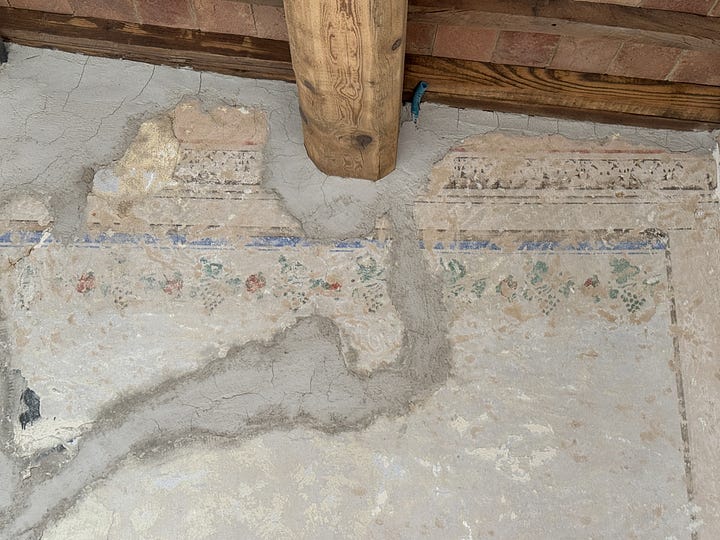
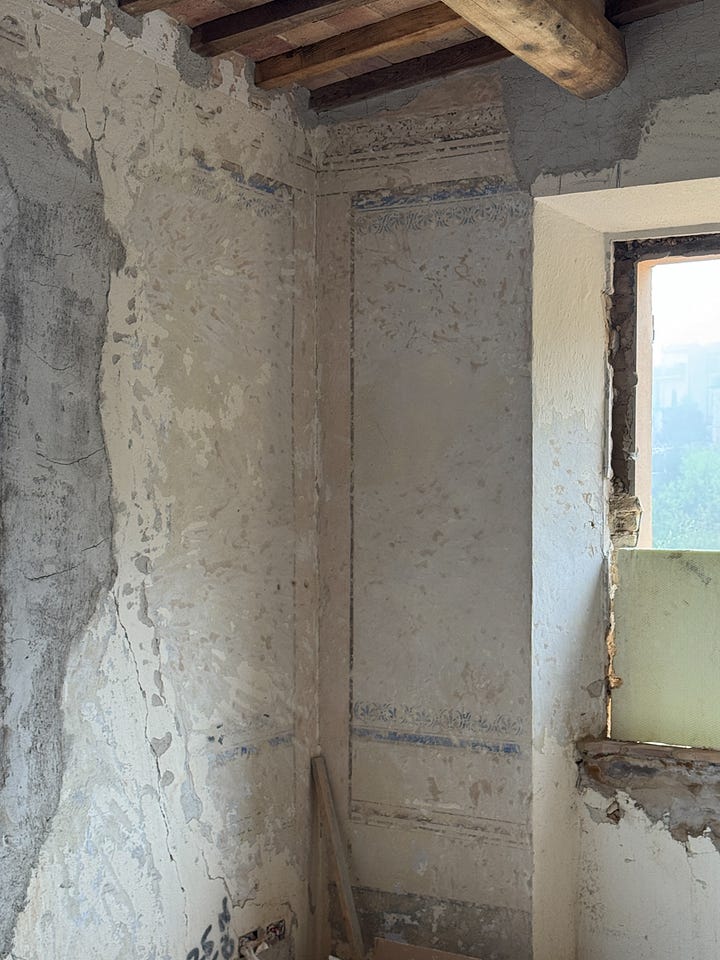
Do they truly date back to the 1800s, we wondered, as we observed them in person. If so, they must be preserved. But if it was a housewife with artistic flair who, following the latest home decor trend, stenciled them on herself in the 1960s, we’re okay to cover them back up.
We asked Massimiliano how old they were. He said that he didn’t know, but noted that decorations like this were typical in homes of this age in the local area. You don’t find them often, he said, because most of them have been covered up over the years.
A little online research confirmed that decorative friezes were a typical feature of early 19th-century Tuscan interiors. 1828, the year the house was built, was part of the late Neoclassical period in Tuscany, a time of relative peace and economic stability during which domestic art and decoration flourished. Artisan painters and decoratori traveled from town to town, painting murals and decorating churches, villas, and bourgeois houses.
Apparently, friezes such as ours were popular, as they added an elegant frame to a room without the expense of full-wall murals. Our motifs are in the light Neoclassical-romantic style, featuring structure and order in repetitive patterns and defined borders, but with fruit and floral bouquets that reflect the softer, slightly romantic aesthetic of the 1820s–1830s.
Okay, then, we’ll save them. Or, at least what we can. Massimiliano asked his crew to carefully reveal as much of the motifs as possible, protect them with a sealant, and then plaster around the prettiest and best preserved sections throughout the room.
Terra Cotta Floors
We have tried to respect tradition and preserve the home's architectural integrity, using natural, locally sourced, and artisan-crafted materials where possible. To that end, the floors will be paved with handmade terra cotta mezzane from a town called Castel Viscardo, in Umbria, just outside Tuscany.
The terra cotta had arrived and was ready to be installed, starting with the upper floor bedrooms and hallway.
Come le vuoi messe? Massimilian asked me. What pattern do I want?
Credo di volere la posa testa avanti, I replied.
Testa avanti, which literally means “head first,” is like a herringbone pattern (spina di pesce in Italian), but the pavers are laid parallel to the walls, rather than at a 45° angle.


La testa avanti va bene? È tradizionale?, I asked. I wanted a traditional layout true to the age and style of the home.
La testa avanti è molto tradizionale, he reassured me.
Testa avanti it is, then.
Vuoi un bordo nelle camere e nel corridoio? Do I want a border around the permiter of the bedrooms and the hallway?
No, nessun bordo. No border.
We want the tile to flow continuously from space to space. Not to mention, there’s not one square wall in the entire house! Borders would be a nightmare.
Hai ragione! You’re right, Massimiliano smiled. Allora, nessun bordo.
The upper-level flooring was installed over the course of our week in Montalcino, and by the time we had to depart, it was nearly complete.
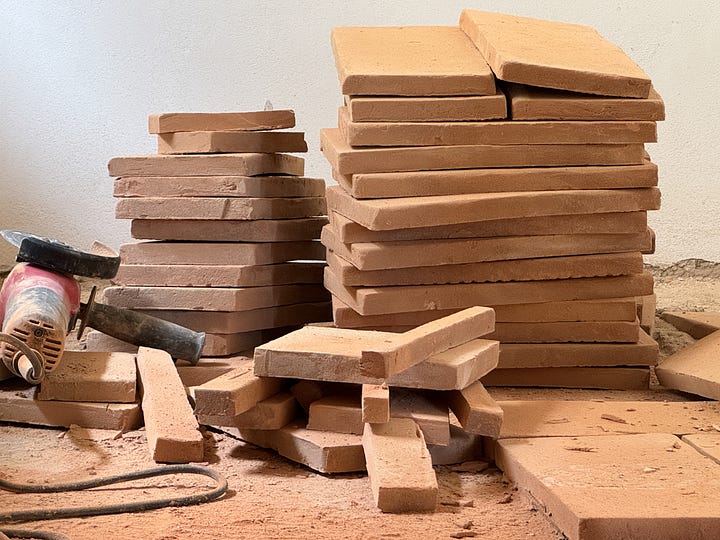

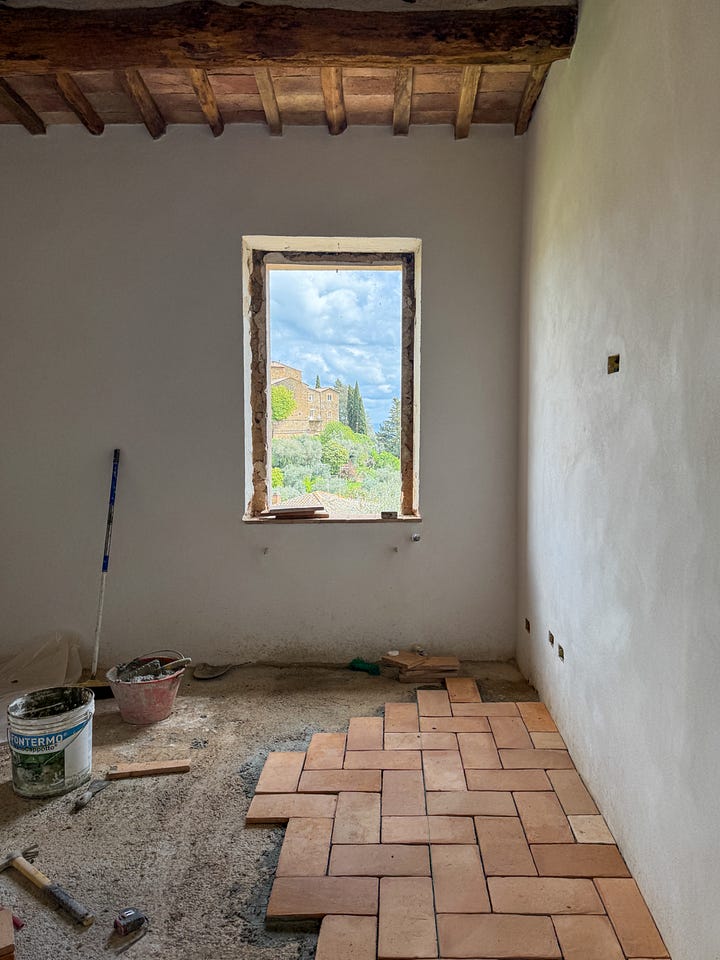
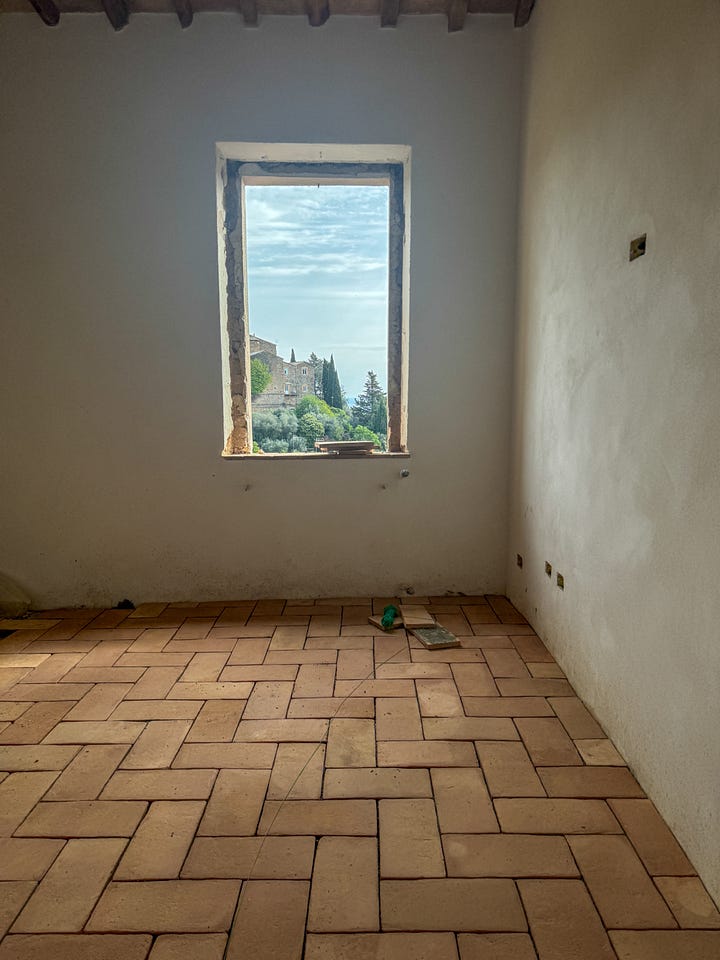

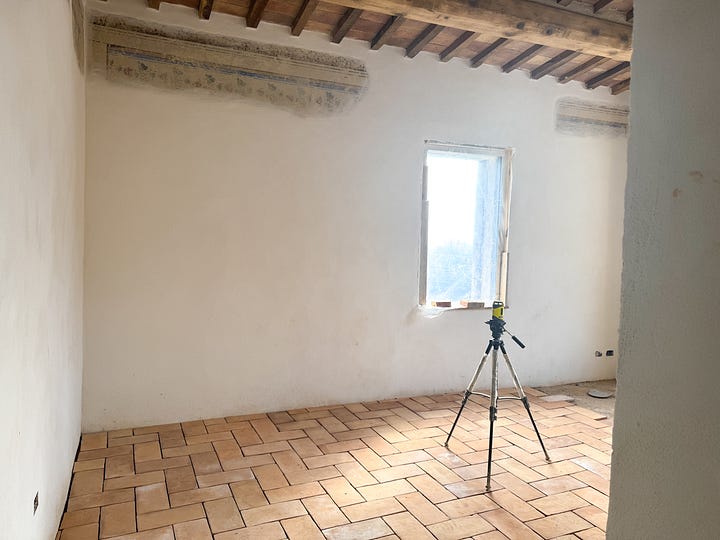
A few hiccups…
It wouldn’t be a remodeling project without a few hiccups. Fortunately, nothing that can’t be resolved with a bit of creative thinking and flexibility.
It turns out that the underground pipe we thought connected to the city waste line at the corner of our property actually dispersed into the soil in our backyard. Yikes! That would be the main drain for the kitchen, a half-bath, and a washing machine. Fortunately, the plumber caught this. Had he not, we would have had a major backup within a week of using the house. Now, a trench will need to be dug through the backyard, and a new pipe will be installed and connected to the city waste line. More work and cost, but disaster averted.
The plumber also told us that the shower pans in the upstairs bathrooms didn’t have the necessary depth for the canalette, or linear drains, we had selected. We took out our phones and started looking up the specs for alternative drains. The ones that worked weren’t a good match aesthetically for the bathroom tile and fixtures we had selected.
After thinking for a minute, the plumber asked if we had heard of linear wall drains, which are installed on the shower wall where the wall meets the floor. We haven’t, but they sound interesting. He pulled up a picture of one on his phone. They are fantastic! We said. They are the perfect solution. “They’re more expensive, though,” he said. Of course they are, I thought. Well, that’s just the way it goes. Let’s do it.
The last challenge is that there’s a pancia, as Italians say, in the façade on the back of the house - a “belly,” right where the new second-floor window was cut out. We were aware of this bulge in the exterior wall, as it had been evident even before the window opening was made, especially when the sun hit that back wall at certain angles. But now, with the window opening cut, you can see that the wall protrudes at least 10 cm, about 4 inches, right in the middle of the window. As a result, it would be impossible to install the shutters on that window, as they would not lie flat against the wall. We pondered what to do.
“You could just go without shutters on that upper level,” Massimiliano suggested. “It’s on the back of the house, so less visible.”
“No,” I replied. “It would look unfinished to leave those two windows shutterless.”
“You probably won’t like this idea either, but we could have fake shutters painted onto the wall,” Gabriele, our geometra, said. “That’s actually done around here.”
I laughed and replied that Stefano had already suggested that. I told him no.
“Well then, the only option is to remove that pancia and smooth the area back over with plaster,” Massimiliano said.
“That means we’ll have to have the entire back side of the house repainted, right?” I asked.
“Yes,” Stefano replied, “but we will probably needed to regardless. With three new windows installed, there are too many touch ups needed.”
“Ok,” said Massimiliano. “Next week, I’ll get scaffolding set up and we will remove the pancia.”
Sometimes, it’s one step forward and two steps back. And, the project cost keeps growing. But we want to address everything now, so that once it’s done, it’s truly done and we can enjoy the property without a “to-do” list to worry about.
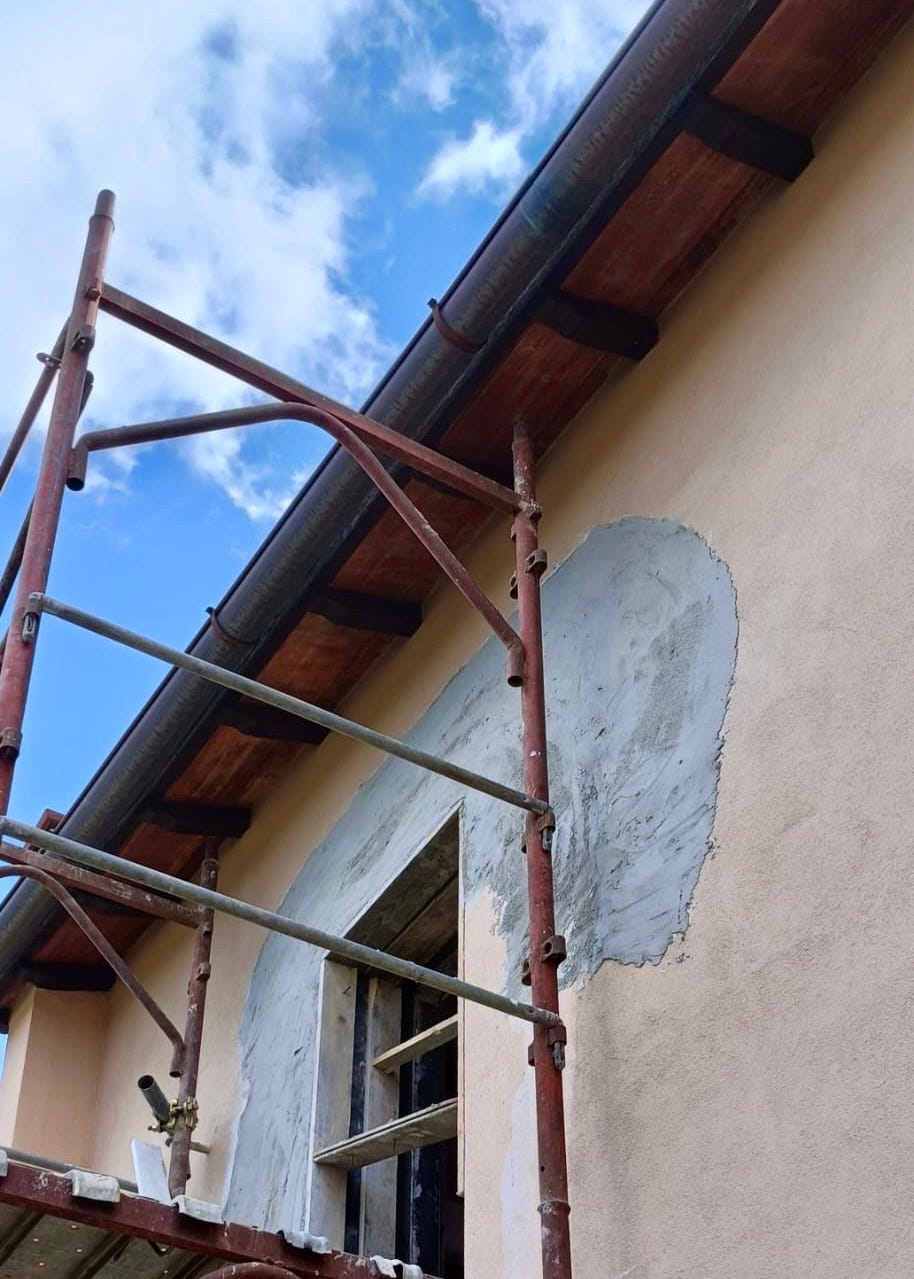
Easter Weekend in Montalcino
Our last weekend in town was Easter weekend. Our son, Luca, took the train from Rome on Thursday evening and spent Friday and Saturday with us in Montalcino. We then drove back to Rome on Sunday to have Easter lunch with Stefano’s mom before Stefano and I flew home again.
It was Luca’s first time in Montalcino, so we did a few touristy things, like visit the Fortezza, a massive medieval fortress built in 1361. The Fortezza sits atop the highest point in Montalcino and was designed to defend the city during the war between the Republic of Siena, to which Montalcino had allegiance, and the Republic of Florence. Even after Siena fell to Florence in 1555, Montalcino held out inside the fortress for four more years, becoming the last stronghold of the Republic of Siena.
"When the house is done, can my friends and I come and stay for the weekend sometimes?" he asked. Of course you can, we replied. We can’t wait until our friends and family can enjoy the house.
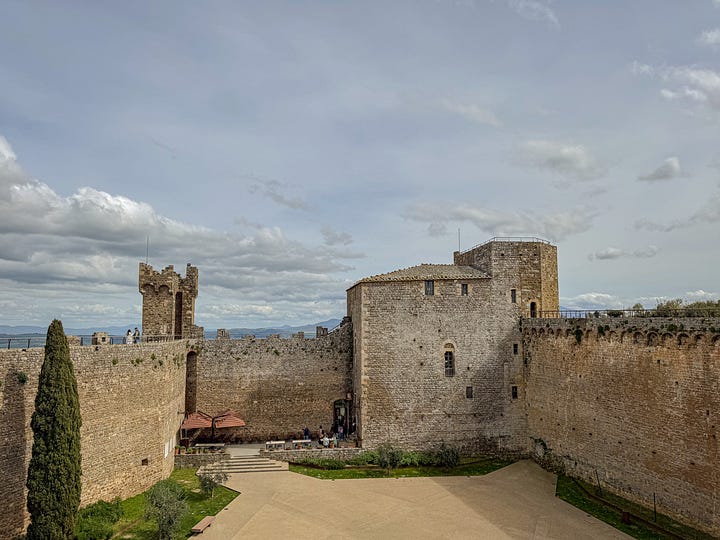
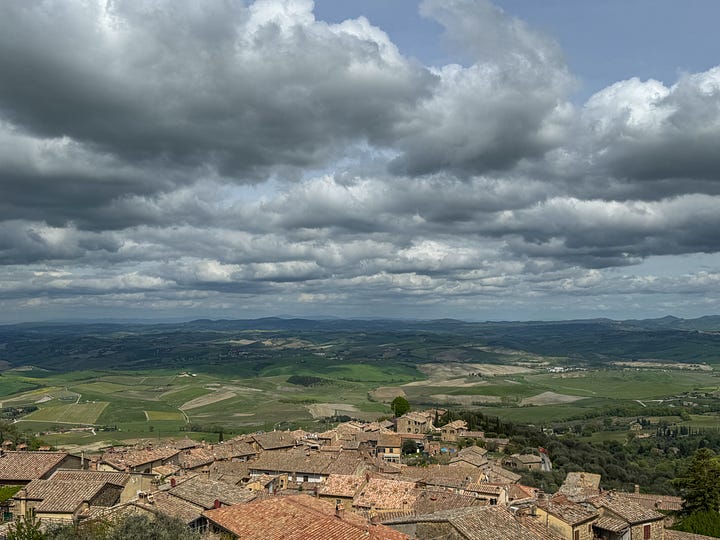
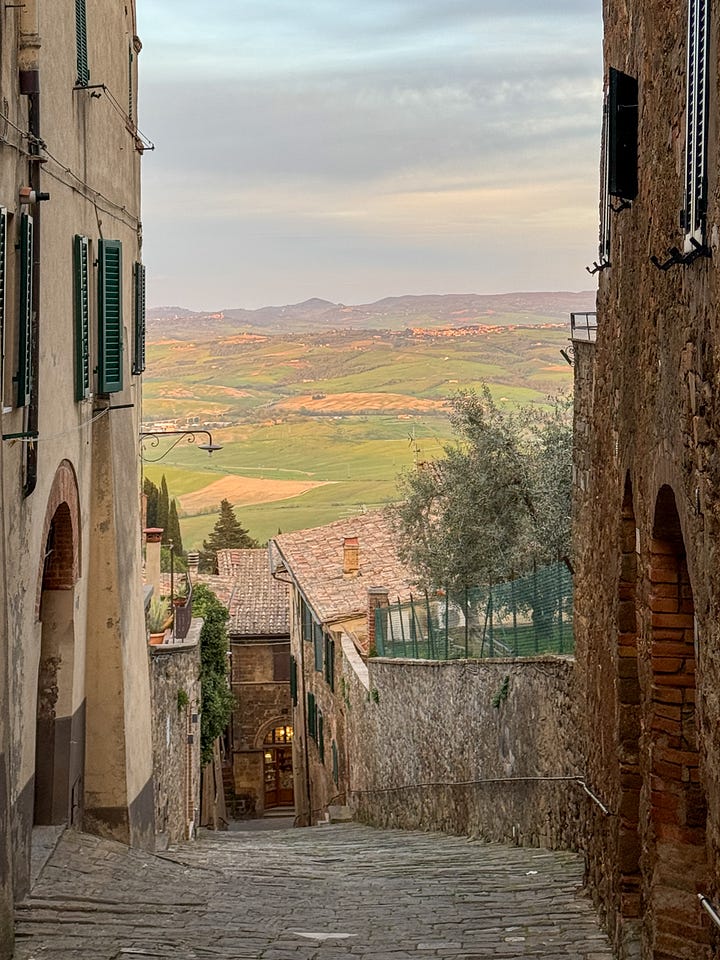
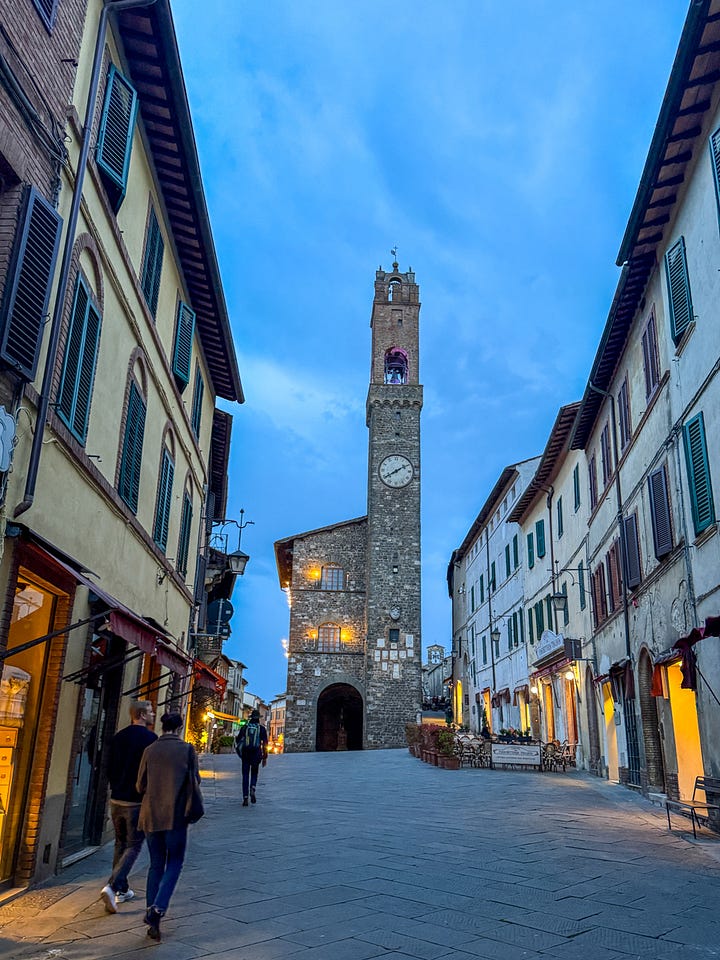
About Montalcino
Montalcino is a medieval town of approximately 6,000 residents, located about 25 miles south of Siena, 85 miles south of Florence, and 145 miles north of Rome. Perched on a hill in the heart of the world-class Brunello di Montalcino wine-producing region, Montalcino has scenic views of the olive groves and vineyards of the surrounding countryside. Visitors come from all over the world to enjoy the town’s cultural events and to experience its wine tourism. It’s long been one of our favorite places to visit.







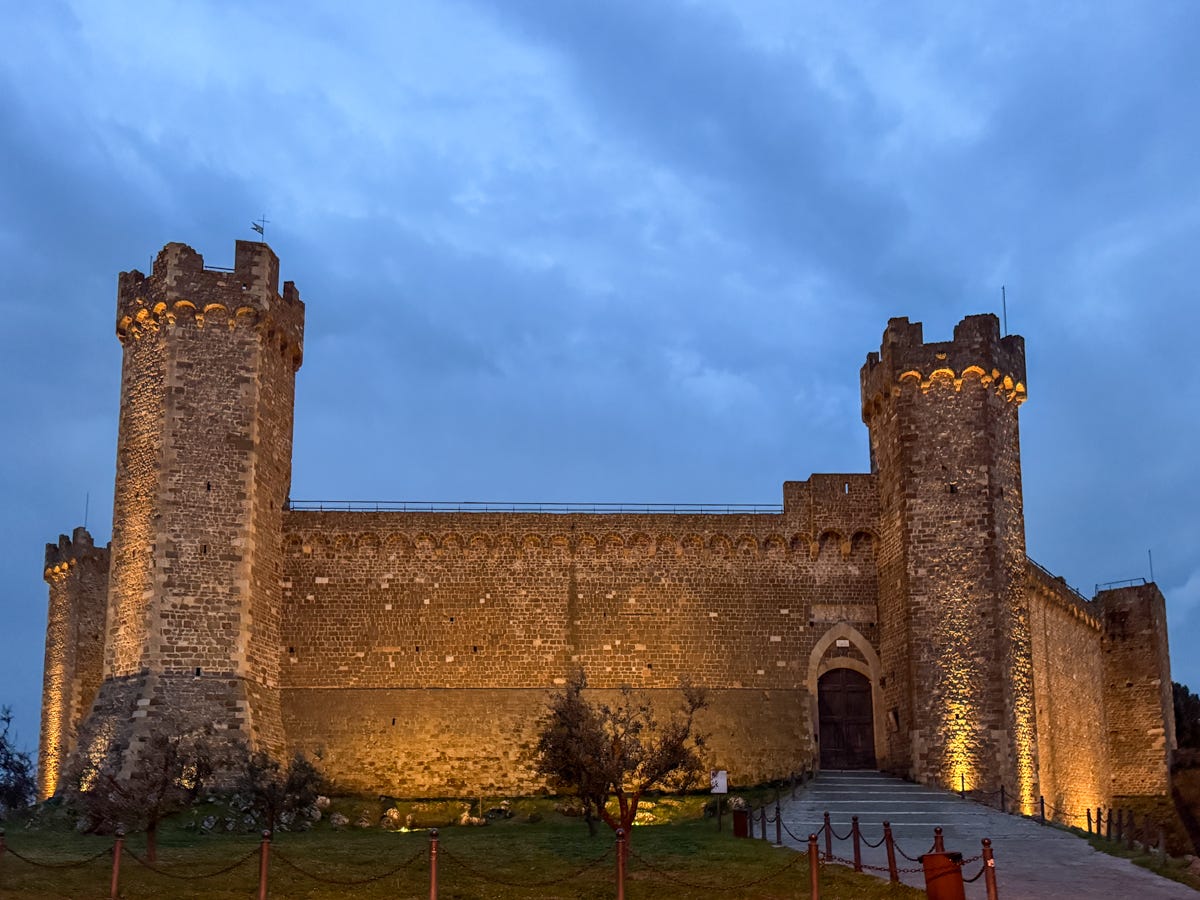
Wow, wow, wow! I love this adventure!
What an amazing place! I don’t think I’d ever grow tired of that view